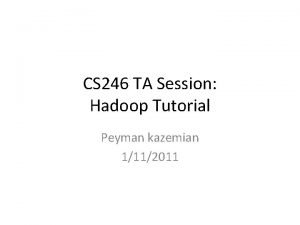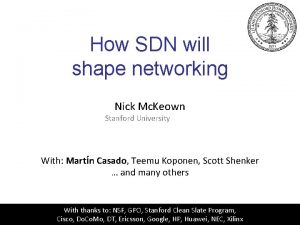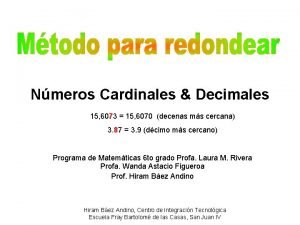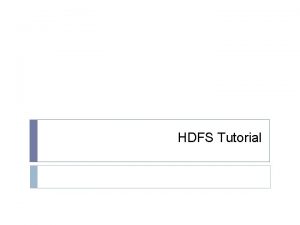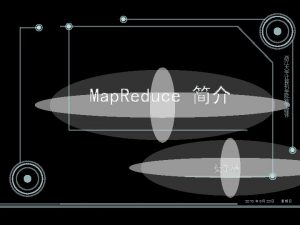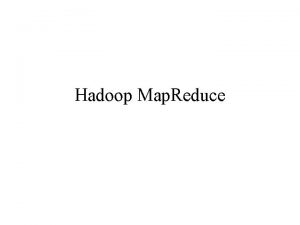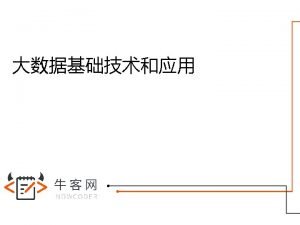CS 246 TA Session Hadoop Tutorial Peyman kazemian









![Word. Count Example public static void main(String[]args) throws IOException{ Job. Conf conf = new Word. Count Example public static void main(String[]args) throws IOException{ Job. Conf conf = new](https://slidetodoc.com/presentation_image_h/f27e637a628f0c3166635262e58a57cd/image-10.jpg)



- Slides: 13

CS 246 TA Session: Hadoop Tutorial Peyman kazemian 1/11/2011

Hadoop Terminology • Job: a full program – an execution of a Mapper and Reducer across data set • Task: An execution of a mapper or reducer on a slice of data • Task Attempt: A particular instance of an attempt to execute a task on a machine

Hadoop Map Reduce at High Level

Hadoop Map Reduce at High Level • Master node runs Job. Tracker instance, which accepts Job requests from clients • Task. Tracker instances run on slave nodes • Task. Tracker forks separate Java process for task instances • Map. Reduce programs are contained in a Java JAR file. Running a Map. Reduce job places these files into the HDFS and notifies Task. Trackers where to retrieve the relevant program code • Data is already in HDFS.

Installing Map Reduce • Please follow the instructions here: http: //www. stanford. edu/class/cs 246 -11 mmds/hw_files/hadoop_install. pdf Tip: Don’t forget to run ssh daemon (Linux) or activate sharing via ssh (Mac OS X: settings --> sharing). Also remember to open your firewall on port 22.

Writing Map Reduce code on Hadoop • We use Eclipse to write the code. 1) Create a new java project. 2) Add hadoop-version-core. jar as external archive to your project. 3) Write your source code in a. java file 4) Export JAR file. (File->Export and select JAR file. Then choose the entire project directory to export)

Writing Map Reduce code on Hadoop • Need to implement a ‘Map’ and ‘Reduce’ class. They should have ‘map’ and ‘reduce’ methods respectively. void map(Writable. Comparable key, Writable value, Output. Collector output, Reporter reporter) Void reduce( Writable. Comparable key, Iterator values, Output. Collector output, Reporter reporter)

What is Writeable? • Hadoop defines its own “box” classes forstrings (Text), integers (Int. Writable), etc. • All values are instances of Writable • All keys are instances of. Writable. Comparable because they need to be compared. • Writable objects are mutable.

Word. Count Example import java. io. IOException; import java. util. *; import org. apache. hadoop. fs. Path; import org. apache. hadoop. io. *; import org. apache. hadoop. mapred. *; public class Word. Count{ public static class Map extends Map. Reduce. Base implements Mapper<Long. Writable, Text, Int. Writable> { … } public static class Reduce extends Map. Reduce. Base implements Reducer<Text, Int. Writable, Text, In. Writable> { … } public static void main(String[]args) throws IOException{ … } }
![Word Count Example public static void mainStringargs throws IOException Job Conf conf new Word. Count Example public static void main(String[]args) throws IOException{ Job. Conf conf = new](https://slidetodoc.com/presentation_image_h/f27e637a628f0c3166635262e58a57cd/image-10.jpg)
Word. Count Example public static void main(String[]args) throws IOException{ Job. Conf conf = new Job. Conf(Word. Count. class); conf. set. Job. Name("wordcount"); conf. set. Output. Key. Class(Text. class); conf. set. Output. Value. Class(Int. Writable. class); conf. set. Mapper. Class(Map. class); conf. set. Reducer. Class(Reduce. class); conf. set. Input. Format(Text. Input. Format. class); conf. set. Output. Format(Text. Output. Format. class); File. Input. Format. set. Input. Paths(conf, new Path(args[0])); File. Output. Format. set. Output. Path(conf, new Path(args[1])); try{ Job. Client. run. Job(conf); }catch(IOException e){ System. err. println(e. get. Message()); } }

Word. Count Example public static class Map extends Map. Reduce. Base implements Mapper<Long. Writable, Text, Int. Writable>{ private final static Int. Writable one = new Int. Writable(1); private Text word = new Text(); public void map(Long. Writable key, Text value, Output. Collector<Text, Int. Writable> output, Reporter reporter) throws IOException{ String line = value. to. String(); String. Tokenizer tokenizer = new String. Tokenizer(line); while(tokenizer. has. More. Tokens()){ word. set(tokenizer. next. Token()); output. collect(word, one); } } } TIP: For cache coherency, define your intermediate values outside loops. Because Writable objects are mutable, this avoids unnecessary garbage collection

Word. Count Example public static class Reduce extends Map. Reduce. Base implements Reducer<Text, Int. Writable, Text, Int. Writable>{ public void reduce(Text key, Iterator<Int. Writable> values, Output. Collector<Text, Int. Writable> output, Reporter reporter) throws IOException{ int sum = 0; while (values. has. Next()){ sum += values. next(). get(); } output. collect(key, new Int. Writable(sum)); } } CAUTION: values. next() returns the reference to the same object everytime it is called. So if you want to store the reducer input values, you need to copy it yourself.

References Slides credited to: • http: //www. cloudera. com/videos/programming_with_hadoop • http: //www. cloudera. com/wp-content/uploads/2010/01/4 Programming. With. Hadoop. pdf • http: //arifn. web. id/blog/2010/01/23/hadoop-in-netbeans. html • http: //www. infosci. cornell. edu/hadoop/mac. html
